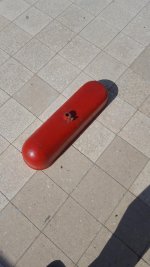Shalom from the USA and welcome to our forum !
The drill press you have has a lot of familiar design features. The big clue is whether the screw threads are US, British, or Metric and measurements of the parts are English or Metric.
The head of the drill press lacks 2 features found on the common US drills of this type: a depth stop rod, and a handle to clamp (lock) the spindle in position so it cannot move up or down.
The center shaft coming up from the column is quite heavy, and aside from supporting the belt guard, could also have been intended for another step-cone pulley to give lower drilling speeds. Not seeing a table that slides up and down the column of the drill is also a bit odd, and might have provided some further clue as to who made the drill.
It does have resemblance to a US-made "Delta" drill press. My wife & I made a vacation trip to Israel in 2016. During that trip, we visited the underground ammunition factory museum outside Tel Aviv. In that museum, there is a South Bend heavy 10 inch lathe and a Delta drill press displayed. However, on your drill press, the belt guard looks a bit different than what I recall seeing on Delta drill presses. Another possibility is a very old "Powermatic" drill press, also a US made made machine tool as they used a similar belt guard to yours.
As for stripping the paint, I'd suggest using a chemical stripping agent rather than emery cloth or wire brushes. Something like kitchen oven cleaner used to remove baked-on grease from home ovens might work. This often has an alkali or caustic chemical content and can remove paint and washes off with water. It should loosen the paint and you can then scrape some of it off and hopefully not hurt any ID plates under the paint. I would also suggest using what are known as "Scotchbrite" scouring pads. These are often used in home kitchens to scrub out pots and pans and clean sinks. Once you get the paint loosened, using this type of pad is less agressive than emery cloth or hard scraping.
I do not know how far you intend to go in taking the drill press apart. The spindle and quill (the spindle being the actual turning part which has the Morse taper socket for the chuck) and the quill (the part which does not turn and has the spindle bearings and also has gear rack teeth on it) are in the head of the drill. The feeding of the quill/spindle assembly is done by means of a pinion on the shaft with the handlever. This pinion shaft is connected to what is known as a "clock spring" on the left side of the head of the drill. As the quill/spindle is lowered, the clock spring is wound tighter and will return or raise the quill/spindle. In looking at your photos, that clock spring assembly seems to be missing and has been missing for some time given the paint build-up. This will simplify the disassembly.
The pulley on the spindle is another matter. This should have some fairly large ball bearings in it which press onto a machined section of the head of the drill press. In that way, the force of the drive belt is transmitted into the head of the drill press rather than as a side-load on the spindle. Removing the spindle pulley may require a puller and some imagination. A word of caution is that the bearings in those pulleys are often quite expensive. The spindle typically will have two sealed ball bearings and may require a press and snap ring (spring retainer ring) pliers to take things apart. Other drills simply need a soft-face hammer and a little care and thinking.
Your drill press is of a very common design, and if you have questions as to the maintenance, setting up, use, etc, I am happy to help you.





